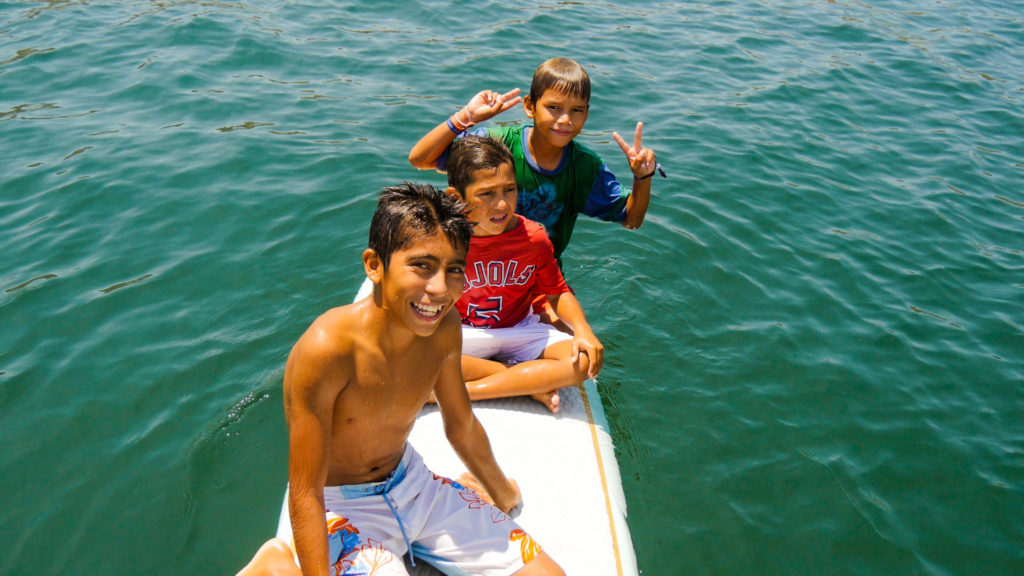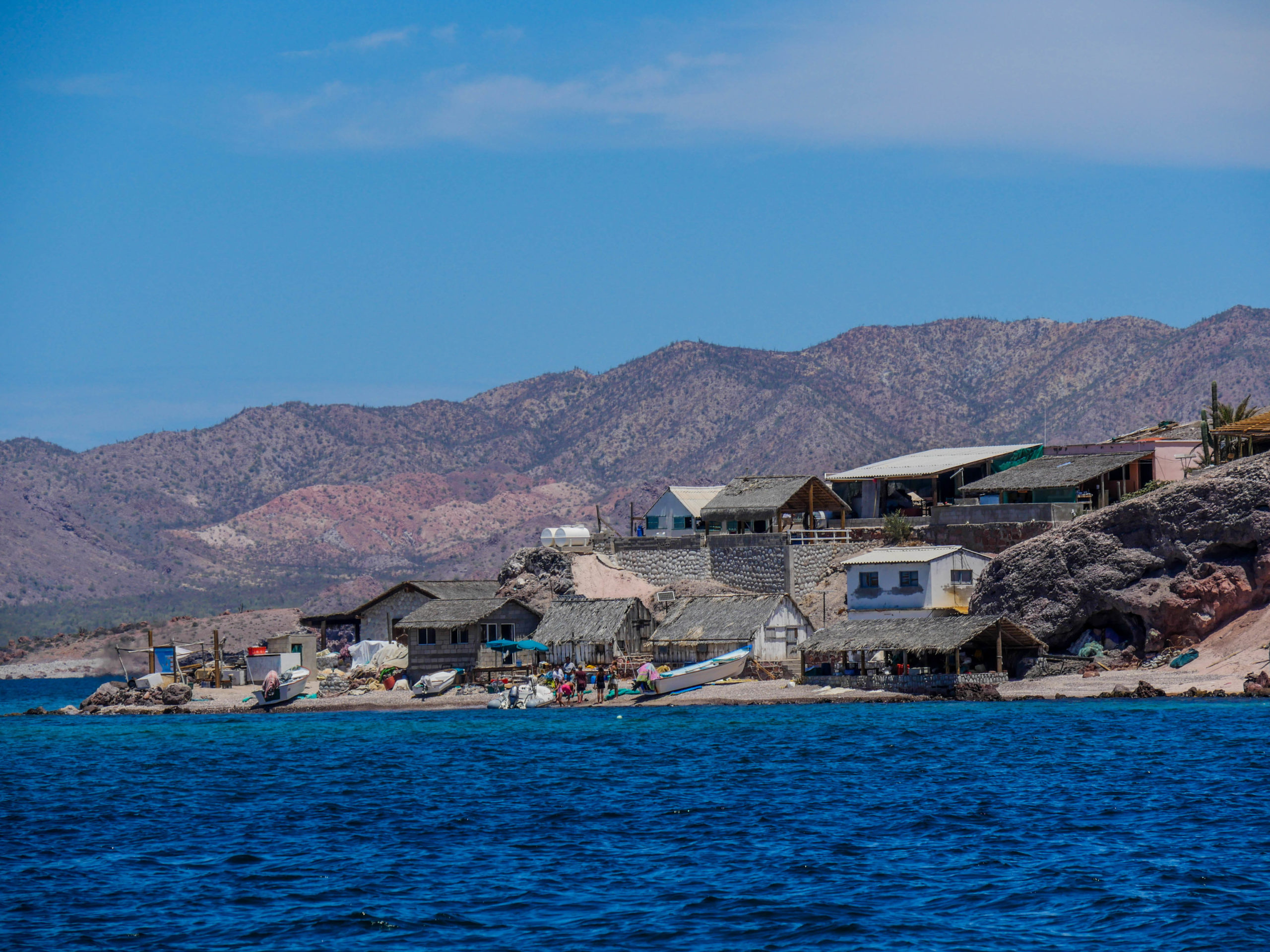No paved roads, no power lines, no fresh water. As we set the main sail and aim north, we travel into one of the most remote areas in North America.
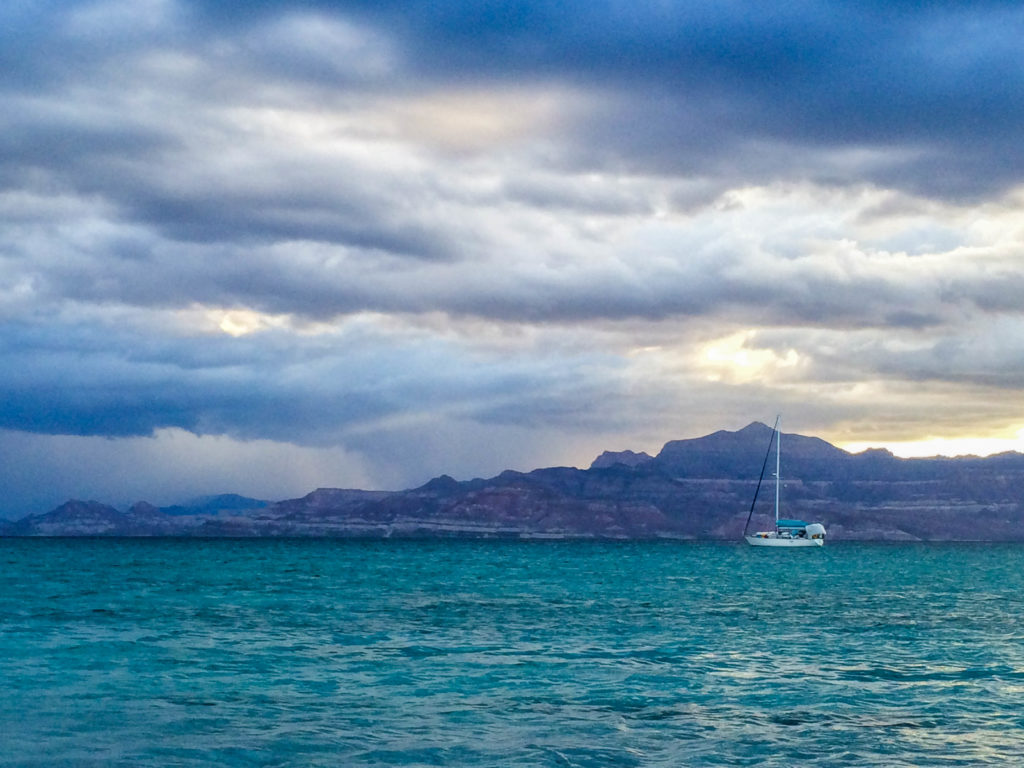
From above, this coast looks void of human influence. A typical US coastal square kilometer contains 200 people. On average, only two souls inhabit each kilometer along the coast we will sail. Over the next three weeks, we travel at the mercy of the capricious Sea of Cortez weather and away from all cell phone service. Our destination is Puerto Escondido, a naturally protected ‘Hidden Harbor’ 120 nautical miles to the north. This is not the Puerto Escondido of big wave surfing fame on mainland Mexico, but the ‘hurricane hole’ where boats stand the best chance of ridding out a big storm in Baja.
All we know about the places we will visit along the way is that they are the haunts of fishermen, tucked into the Sierra de la Giganta Mountains, which rise sharply from the sea. The people are poor and isolated from each other and the rest of the world.
What I didn’t know was how wrong I was.
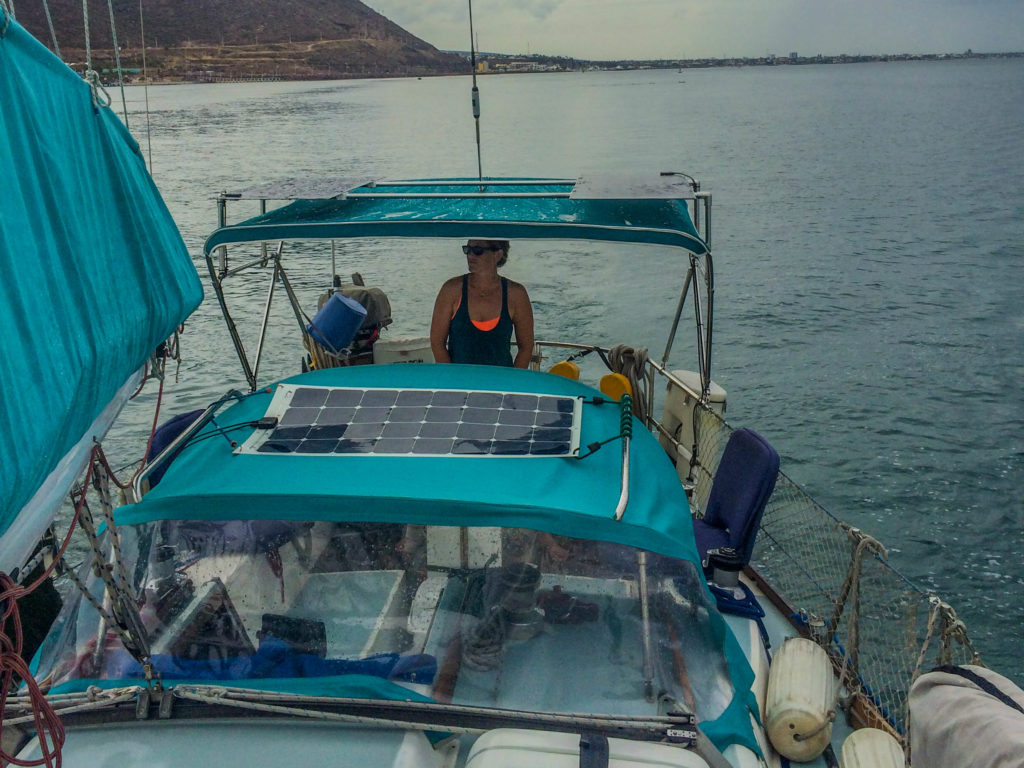
Isla Espiritu Santo
Islas Espiritu Santo and Partida, our first stops, lie 20 miles north of La Paz. Since 2003, these two islands are part of a marine national park, which was purchased and preserved by an alliance of Mexican and US conservation organizations. These groups invested in the Sea of Cortez because it is the second most diverse body of water in the world. Thirty-one species of whales and dolphins (one third of the world’s total) live or travel here, and 500 different species of identified fish share the water with breeding sea lions and turtles.
The islands bear the scars of past exploitation. At the end of the 1800s, pearl harvesters gobbled up the naturally-occurring oysters and their precious cargo. The pearls were usually opalescent blues and purples, and divers would work from boats with sails and oars. In La Paz, one pearl baron made his fortune harvesting the Espiritu Santo pearls, only to be stripped of his riches and jailed after the Mexican Revolution in 1920. By then the natural supply was exhausted, and all that remains of this industry are the crumbling canals used to grow oysters on Isla Espiritu Santo. It took only a few decades for the pearls to be wiped from the sea. When John Steinbeck visited La Paz in 1940, the folklore of pearls and greed would inspire his novella The Pearl.
We sail past the pearl farms, which are in coves unprotected from the summer nighttime swells, so we can’t anchor here. We aim for the narrow divide between Espiritu Santo and Partida. As we pull into the cove, a fisherman in a panga, the ubiquitous open skiff of small-scale fishermen, motors over and loiters awkwardly close as we set our anchor. He says he is the only person on the island, and offers to take us to a cave. When Josh politely declines the offer, I have to rescind my enthusiastic yes as I realize Josh declined for an unspoken reason. The fisherman stands in his panga holding the rail of our boat and watching us as we tidy, uncomfortably present and silent.
Does he want something? “No.” Just conversation? Arnulfo nods and smiles bashfully. He tries out our paddleboard, teetering at first but quickly moving to his knees.
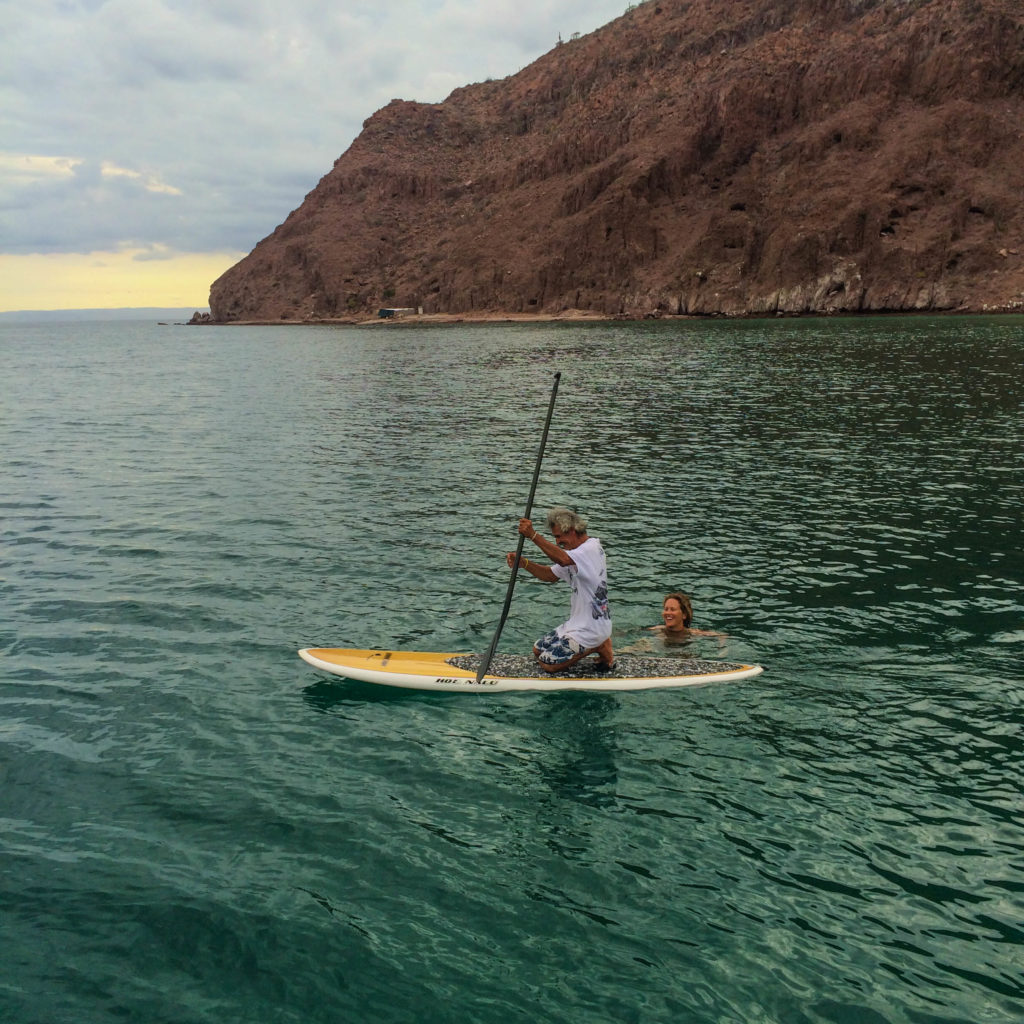
When Arnulfo finally departs for the fish camp on the sand bar between the two islands, Josh mentions that he found the fisherman odd. Despite telling us he was solo on the island, we can hear him laughing with another man on the distant beach. We are the only boat anchored in this cove, and the evening darkness creeps in. I want to talk more with Arnulfo tomorrow, but I know that Josh will be wary enough to not sleep—and that makes me wary enough to worry. But we don’t want to be chased away from an anchorage at sunset just because we’re unreasonably spooked. We keep asking each other what the other thinks.
“Let’s get out of here,” I say as I finally make up my mind.
This is the nature of our journey—Josh and I depend on our mutual trust, but not without self-doubt and an unspoken systems of best guesses made as a team. We are uniquely exposed here, since we are the only anchored boat, and we’re not sure where the next closest boat might be for radio contact if there is any trouble. Josh starts the motor, and I walk the deck barefoot to the bow, where I use a big metal ratchet called a windlass (pronounced WIND-less) to mechanically haul up the 140 feet of thick anchor chain and our 50 pound anchor. Most sailors have an electric windlass and press a button, but we stand in the anchor locker, the hatch where the chain lives, and use a long leveraging rod to crank the chain back onto the boat. As we motor out of the cove, Josh second guesses himself, saying that the fisherman is probably only awkward. But we decide to avoid a sleepless, anxious night, and stick with our decision.
Instead, we lose sleep for a different reason in the next cove: weather. We motor in with our lights on, one small white light on the top of the mast, and two lights on the bow, green to starboard and red to port. We glide in under the complete darkness of a cloudy, drizzling night. This cove, Ensenada Grande, has steep red rock walls and a sliver of beach. We find a catamaran, a luxury powerboat, and a giant SCUBA mini-cruise ship with a whining engine to power their air conditioning. Although we would prefer the cove to ourselves, these neighbors are typical of the boat traffic in the sea, and we can relax, even if they have annoyingly loud generators. We tuck in as close to the south wall as we dare, then wolf down some mac and cheese as the wind picks up and begins to toss the boat around at anchor.
Josh and I usually sleep in the “v-berth,” the front of the boat, which means that we sleep with our heads at the base of a triangle and our feet crammed into the top. There is a large hatch over our head here, and since a boat usually swings to face into the wind, we catch the breeze—a relief in nights that don’t get below 90 degrees. However, the v-berth is also the least stable part of the boat: every wave lifts the bow and slams it back into the water. Therefore, as the wind picks up and whips up steep wind waves, the v-berth rocks up and down like a really-not-fun amusement park ride. Tonight we buck so violently I start to get dizzy. After two hours, my self-imposed limit for horizontal discomfort, I grab a sheet and stumble outside to the cockpit. Here, the bouncing is a little muted (the back of the boat moves less,) and the outside air feels refreshing. However, the lights and the constant high-pitched engine noise from the dive boat generator make sleeping almost impossible. I fitfully doze amid passing showers that sprinkle my sweaty skin.
The wind continues to howl in the morning, and more thunderheads loom over the backside of the island. Should we stay and wait out a possible storm, we ask each other as the bow hits another wave that feels like concrete. Josh tunes our SSB (single side band) radio to a daily broadcast of weather for the Sea of Cortez. The SSB uses the backstay, the three-eighths-inch stainless steel wire that secures the mast to the back of the boat, as an antenna. We can communicate and listen to broadcasts over great distances; if we timed it right, we could call out to space. But today, the steep walls of our anchorage block some of our local weather news. Even if we had a forecast, we’re learning that the weather in the Sea of Cortez involves microclimates and dazzlingly changeable conditions from one moment to the next. We must decide what to do without a prediction.
* * * * *
Both Josh and I have plenty of experience with adverse weather, but Josh’s knowledge comes from a life lived on the water. Josh grew up sailing and surfing on Alabama’s Gulf coast, and even though his family moved to landlocked Birmingham when he was young, the ocean stayed in his soul. Josh and his younger brother learned from their father how to frame a house, rebuild an engine, wire an electrical system, and calmly figure out how to fix anything broken. The muggy heat of the south, combined with endless hours fishing and carving waves on a surfboard, molded Josh into a serene, laidback man.
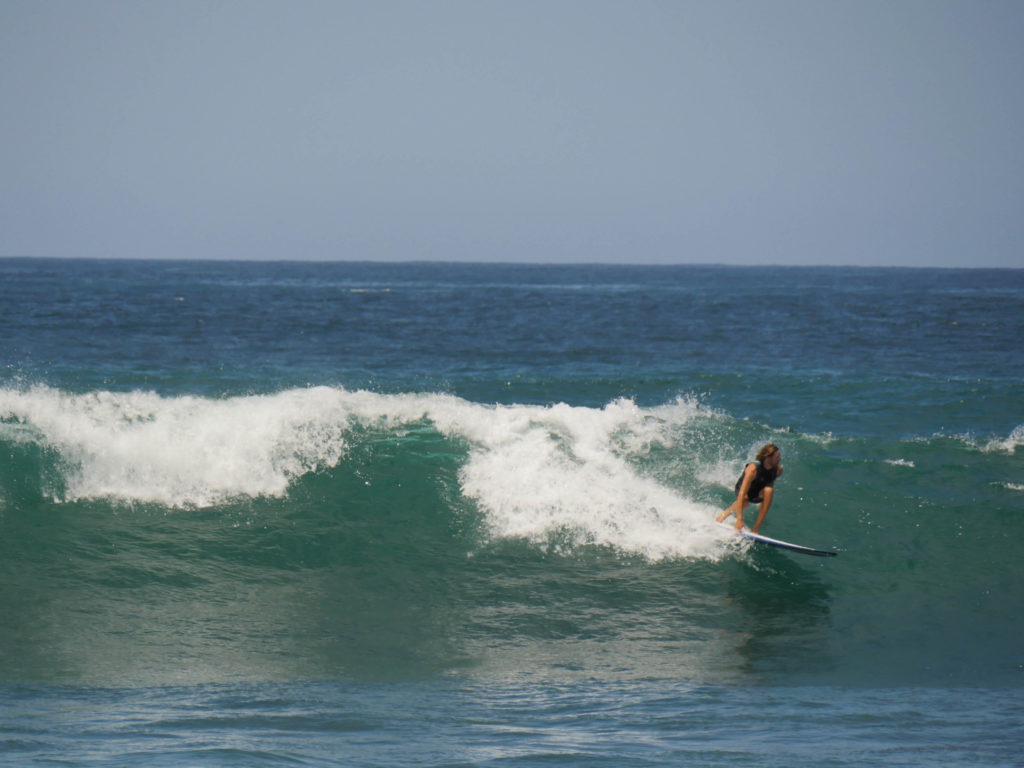
After college in North Carolina, where he focused on experiential education, he based himself on a barrier island one state south, at Folly Beach, South Carolina. He delivered boats to and from Bermuda and the Caribbean; worked to build a 140-foot schooner; started a kitesurfing business from the decks of his 27-foot sailboat, Althea. For years, he taught kids to sail aboard a 150-foot schooner in the Channel Islands. After living in the Bahamas and teaching small-scale solar energy installation, he earned a degree in wooden boat building from a prestigious school in Port Townsend, Washington, then moved to the San Francisco Bay Area with his 40-foot Bristol Channel Cutter (read: a very well-built and sought-after wooden sailboat the envy of sailors twice his age.) I met him in the Berkeley boatyard the day I purchased Oleada.
We knew within weeks of meeting each other that my sail south was now a joined goal with intertwined expertise. I had learned to sail a couple years before, and although I was guided by instincts honed from ten years as a field biologist and backcountry guide, I had no idea how to rebuild the raw water pump on Oleada’s old diesel or install a desalinator. And although Josh had worked in renewable energy and in marine biology education programs, I was able to share 15 years of ecological field knowledge recently honed by my Master’s degree from the Energy and Resources Group at UC Berkeley. We both wanted to sail and explore, but not without a positive, measurable impact on the people subjected to climate-driven change on the coast. With Josh literally on board, my climate mission became infinitely more safe—and possible.
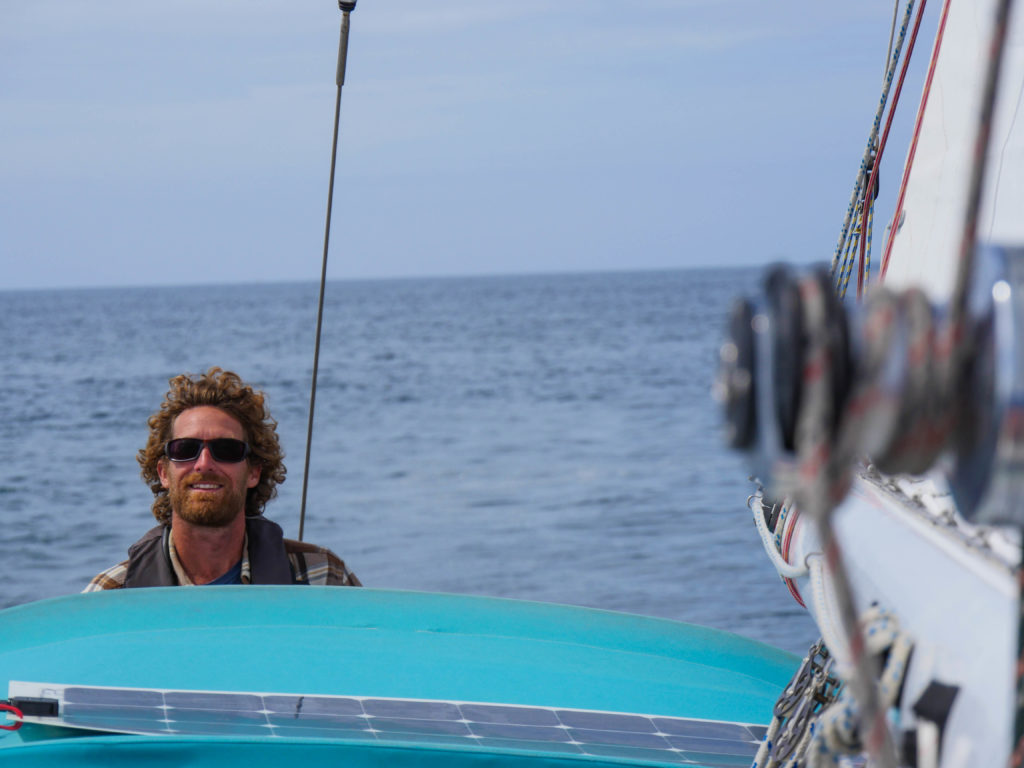
* * * * *
I watch the dark edges of the clouds skirt the southern edge of our island skyline. The wind whips up whitecaps and the water is a hard, dark blue. After observing for a couple of hours, we decide that the storm is staying south of us. Josh hauls up the anchor, and we unfurl the jib, sailing quietly out of the anchorage sans motor.
Isla San Francisco
A few hours later and after four wind shifts, we drop our anchor in a beautiful cove on Isla San Francisco. We revel in the clear water, enjoying our solitude. We hike the island ridge amid the clicking and ‘cherr’ing of Purple Martins and soaring Magnificent Frigatebirds. Yes, a capitalized ‘magnificent’ is part of their name. They have the largest body size per weight of any bird in the world. No flight description is complete without the word “effortless,” as they soar the warm updrafts on angular black wings. These aerial pirates float aloft, ready to dip to the surface of the water to snatch a fish from the water or from another bird.
The Purple Martins enchant me. These large and uncommon swallows keep up a constant conversation of cherrs and chortles while they dip and dive over the rocky island peaks. Their noises remind me of Florida, where I used to listen to them on my grandmother’s porch. This natural beauty is for us alone.
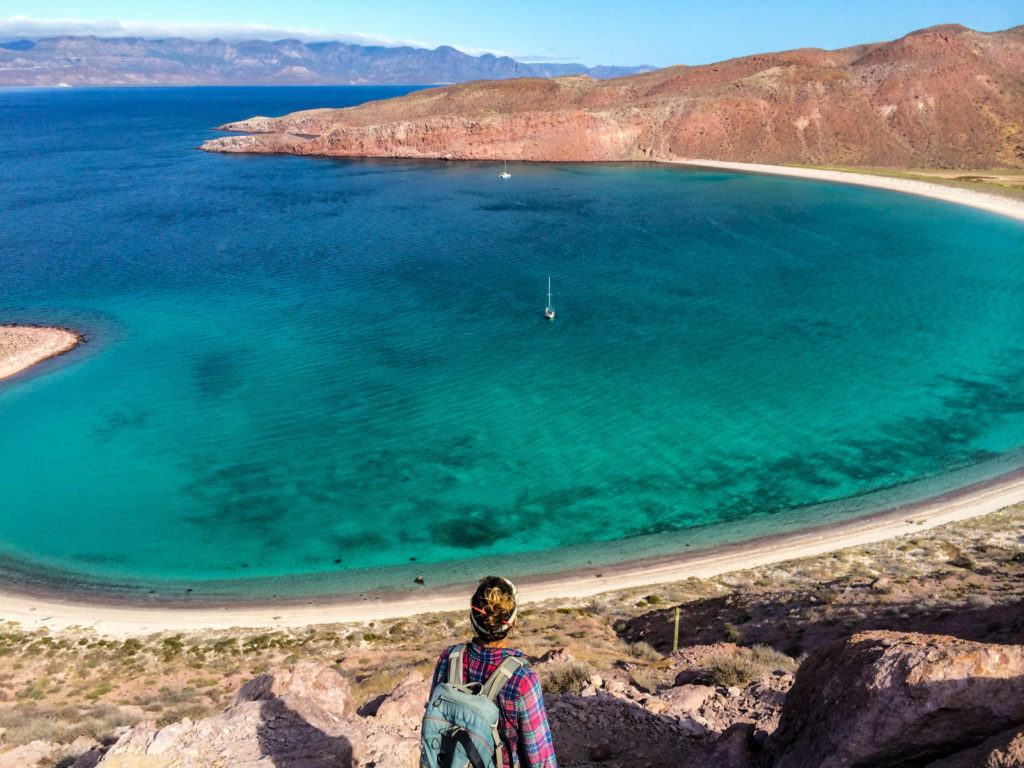
Until we are surrounded by luxury motor yachts. Over the next three days, we are increasingly boxed in by tinted glass and sparkling white boats with shark-like lines and staff in matching polo shirts. We strategically anchored in the south side of the cove for protection from southern swell, and the captains of these five other boats seem to think this is a good idea also, despite their looming size that makes them immune to the swell. They make our 39 feet of boat seem like a rubber ducky bobbing in their wakes. A mix of English and Spanish comes from their decks, though most of the boats are registered in the tax haven of the British Virgin Islands. The staff wave and acknowledge us, but the boat owners seem to think Oleada is invisible. Despite the large anchorage, they anchor so close that we can hear their generators growling to keep their air conditioners pumping—but none of the guest ever wave or smile to us only a few feet away.
We love the island, but this is not our scene. So much for that sparse population map: there are now at least 40 people in the south end of the tiny cove on Isla San Francisco. Fed up, we raise our sails and slip out of the jumble of yachts without our motor. Sailing off the anchor requires coordination and timing, an activity of note among sailors for the skill required. In a gesture of defiance toward the generator noise (that I am almost certain was not appreciated by these motor yachts), we never use our engine to return to the silent sea. Around the north side of the island, we anchor for a night with one unobtrusive yacht.
The following morning, a teenager whips past our boat on water skis, towed by polo-clad staff in a little boat with a huge outboard motor. The small boat draws concentric circles around us. Josh and I are stuck in a bizarre vortex. We have come here to study the impacts of climate change, yet find ourselves surrounded by boats burning fossil fuels at all hours in order to keep their few occupants cool. I haul up the anchor, grumpy, and we make our way only half a mile before anchoring near the smallest inhabited island I have ever seen.
Isla Pardito
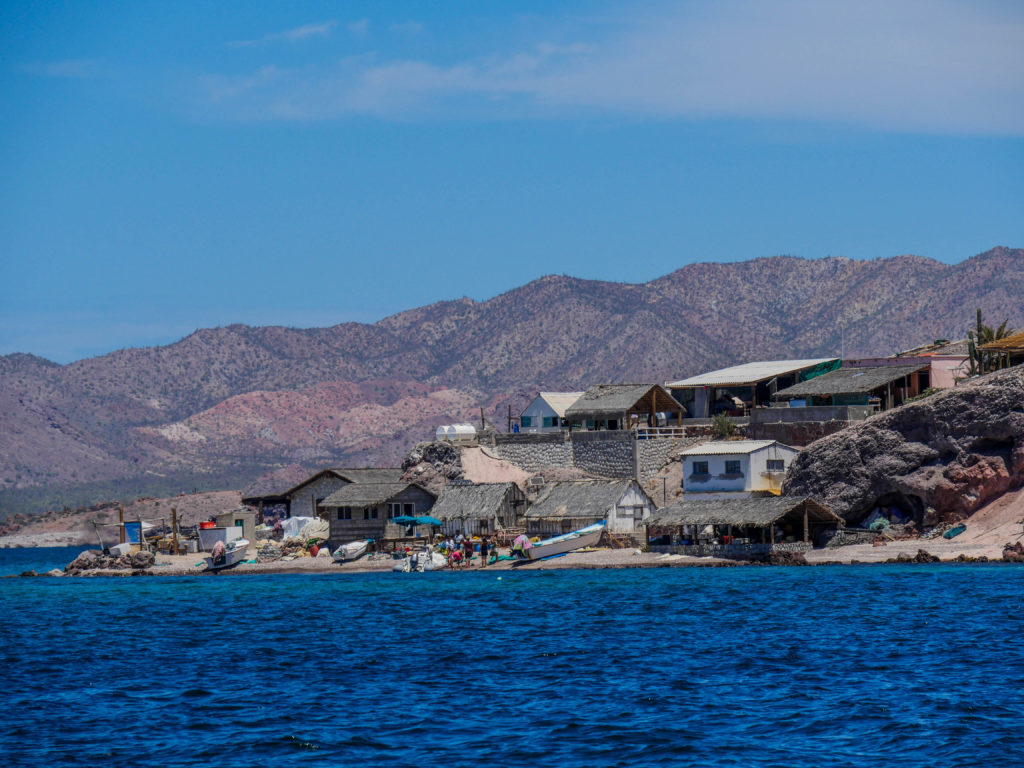
As we row to the pebbled shore, a man steps out from behind one of the concrete cinderblock houses, with window frames but no glass, on the tiny beach. His house is only a few feet from the water. What does he do during a hurricane, when storm swells would submerge his house? As we land he puts his big hand under the gunwales to help us carry the boat away from the shore.
Roberto grins and offers his hand. He’s been living on Isla Pardito for 68 years, though he looks 20 years younger. He lifts his shirt to pat his big, brown belly while he chats with me, a funny habit I’ve seen before and since among the fishermen in the hot summer. I suspect they do this just to cool off. He’s calm, friendly, and relaxed. His whole life he’s worked as a fisherman from this island.
“What’s different these days?” I ask.
“Oh, it’s so much easier!” he says. This surprises me, and he continues, “We used to have to row, and we used sails. Now, with the motor, it’s much easier.” Even into the 1970s we used sails, he says. He knows that we share the knowledge of how complicated fishing can be when one depends on wind, currents, and weather to follow a fish.
On our dinghy, I show him where we can insert a mast to make the rowboat a sailboat. I wonder if he thinks we are ridiculous, moving slowly and laboriously through the sea with our big sailboat and our little dinghy. I sometimes feel conflicted about our boat. Sailing is a tough way to travel, with the privilege of chosen labor. But Roberto leans his head back a little and compliments our dinghy with the genuine appraiser’s eye of a man who lives by the sea.
An older man peers at us from the porch above the shore, and he motions us to walk up the steep hillside. We make our way to his shaded porch, a cool relief under thatch and over a concrete pad. He offers us his hammock and view to the brilliant blue. His name is Pablo, and he firmly shakes our hands. His wife Juanita emerges from the dark interior of their home, whose back wall is the steep island side.
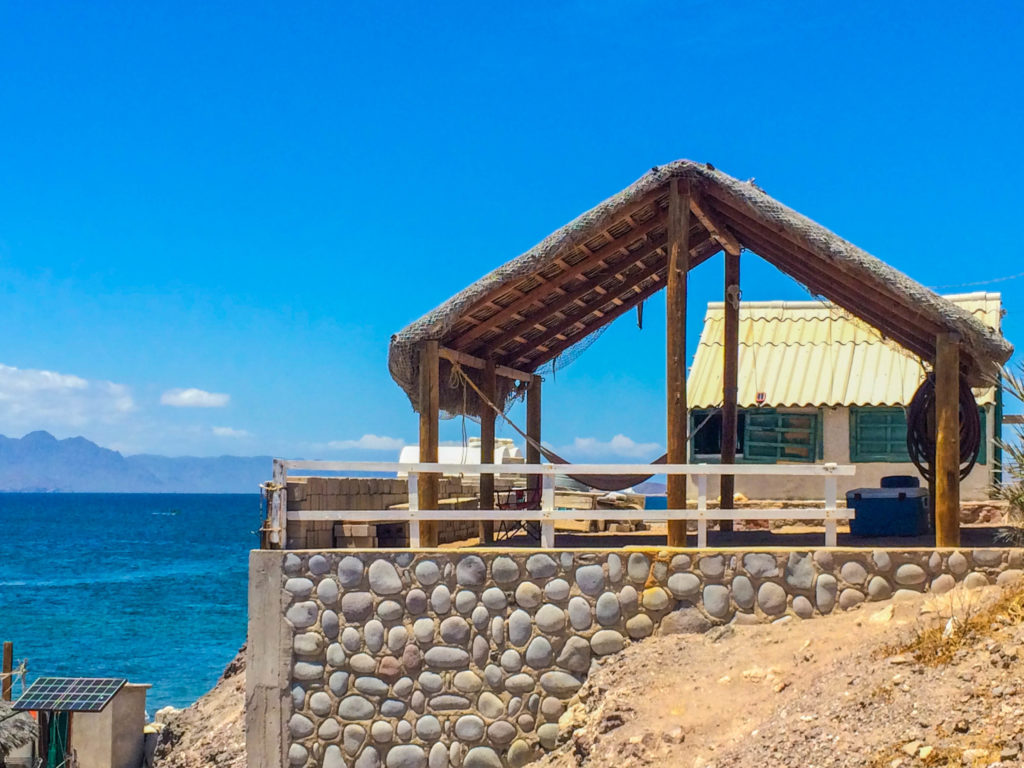
Juanita wears glasses, and her skin is deeply wrinkled. Although shy at first she smiles and responds to my questions. She speaks proudly of her two sons and her daughter whom she raised on the island, and I learn that one of her sons and three other young men from the tiny island have formed a popular band.
When I ask Juanita if things have changed over the 39 years she’s been living on the island, she says it’s much harder now.
“There are so few fish, and the fishermen have to go so much further just to find smaller fish,” she says. She shakes her head and looks out at the sea, worried. I buy a bracelet from her, and we walk the few steps to the top of the island.
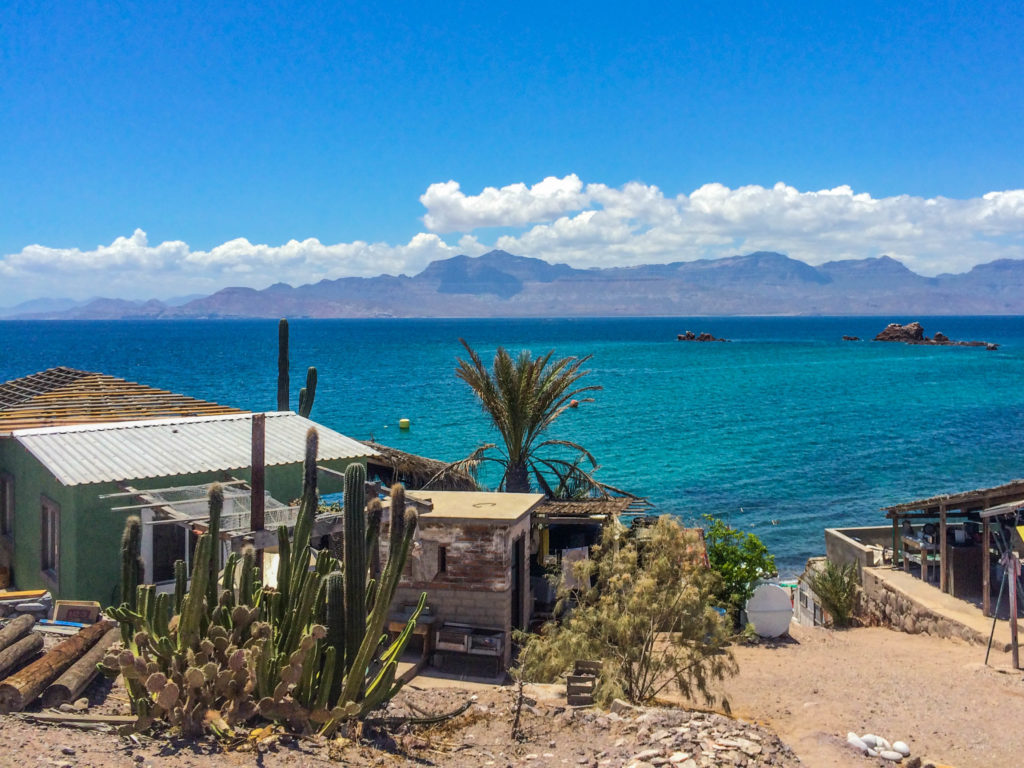
The top is barren except for a little blooming Mammilaria cactus, and a tiny, disused church. Around the island, the million-dollar motor yachts zip between Isla San Jose to our northeast, and Isla San Francisco to the south. “They’re out there every day, and even more on the weekend,” Roberto tells me when I ask about the high dollar traffic. The contrast is laughably stark. They don’t have fresh water here, never mind air conditioning.
Back down on the shore, I turn to Roberto. “What do you do during a hurricane?” I ask.
“We put the boats up high,” he answers immediately. He shows us the places where they tuck away the pangas. But do the houses survive? I ask.
Well, they get quite damaged, he says with a laugh, but they survive. Everything just gets covered in water.
I finally realize that the things I think of as having value on a coast, like structures and houses, don’t have the same meaning here. Roberto answered without pause that they protect the boats. The boats are their livelihoods and their transportation. The houses are structures with minimal belongings. The boats are not their playthings, like the yachts speckling the sea, buzzing the island like white wasps. The pangas connect them with their families–who have diversified the work on the island by ‘commuting’ to La Paz.
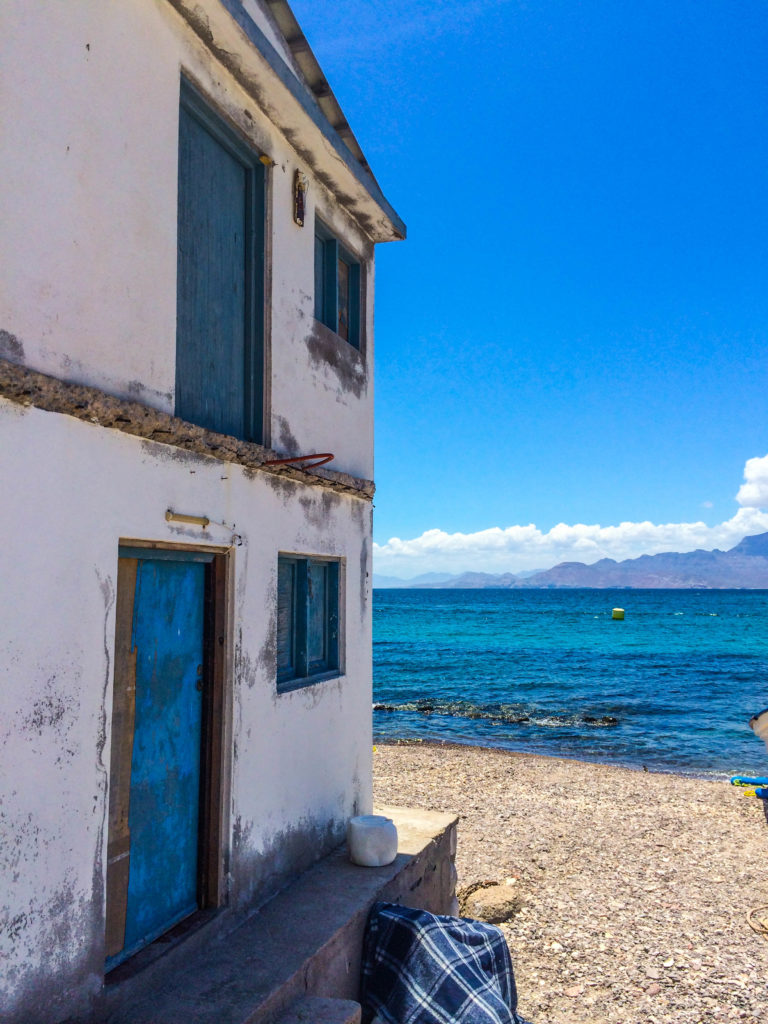
The most valuable thing on the island becomes clear as we leave. A freshly-painted panga, with seats and shade to cover them, pulls up onto the beach. A young man stands at the motor. Pablo hobbles and bounces to the beach with a face written with joy. The handsome young driver is Pablo and Juanita’s son, the guitar player for Los Grandes. I can see a parent’s affection as Pablo gazes at his son. His son smiles at me as both Pablo and Roberto admired our dinghy.
The same families have been on Pardito for four or five generations. Hurricanes, even as they grow stronger, are temporary and typical events for a group of people who live only a few feet from the sea and are bound by its rhythms in work and family. The sustaining tie for this community is not the physical structures on land, but the livelihood from the sea and the family in their hearts.
I realize that the island isn’t much different from a country ranch—it requires a little more effort to reach, but the ocean is their dirt road, and their ranch extends in every direction as far as the eye can see. The family gathers at the center to share stories of life and work. It makes the island seem like just the right size.
As we lift the anchor, I notice that this spectacular piece of sea is, at this moment, only for the financially ultra-wealthy or the poor. The emitters swarm around the island, eating at the shores with their invisible emissions. They could move—if Pardito goes underwater, they can return to waterski over the ruins. The families of Pardito are vulnerable as the earth warms. But the younger generations of Pardito are not stuck to the rock, and even as they embrace the traditions of their families—including traditional music—they carve their own paths out into land. And for now, they can still come home.
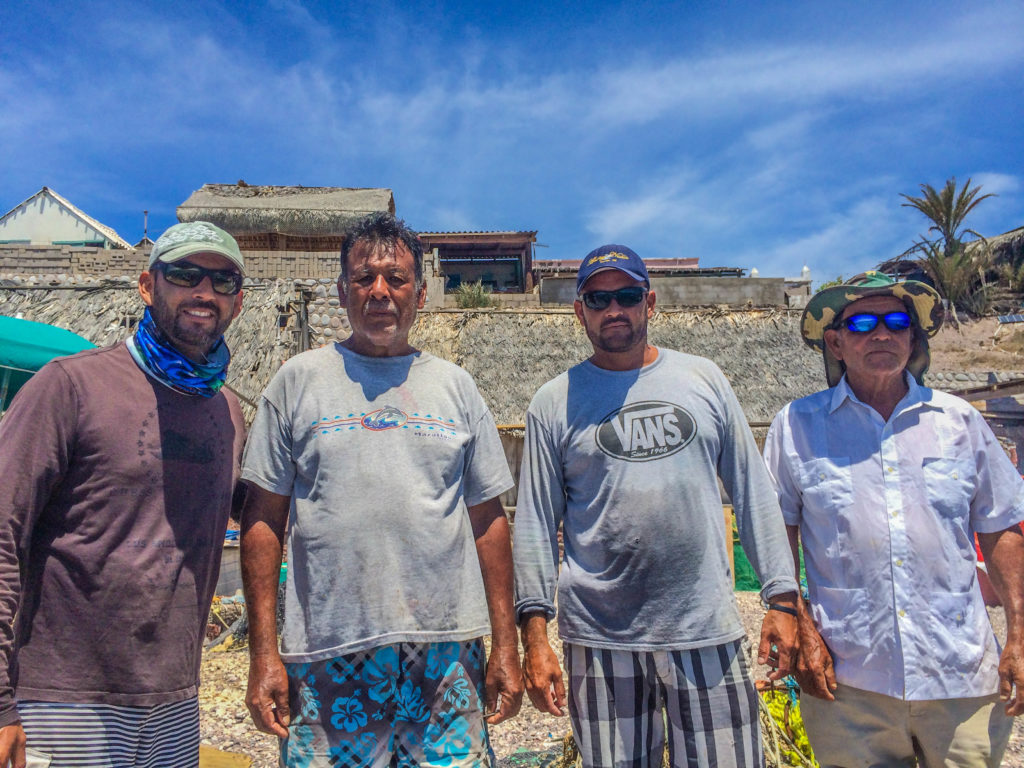
So how soon could an island like Pardito go underwater?
Since pre-industrial times, the ocean has risen eight inches globally. The ocean currently rises about .17 inches per year, but the reason it rises now is different. From 1880 to 1993, the rise was driven by the thermal expansion of gases in water. But since 1993, 75 percent of sea level rise comes from melting ice, whereas this contributed only 50 percent before. In the future, the magnitude and rate of Greenland and Antarctic sheet ice melt will determine the amount of sea level rise over the next 100 years: from eight inches to seven feet.
The sheer volume of water is like a filling bathtub. However, the immediate hazards of climate change causes dangerous and damaging sloshing in the tub. This splashing equates to shoreline erosion, storm surge, and inundation, and this erodes coastlines ahead of the simple rise in water. For example, as tides rise higher, salt water can infiltrate fresh water aquifers, and hurricane storm surges moves further inland, damaging more property and altering the landscape. Heavy rain and wind erode from the other side. This is the growing threat to Roberto, Pablo, and Juanita.
San Evaristo
“Do you think they see us?” I ask Josh. We are anchored in San Evaristo, a mainland fishing community with about 20 dwellings at the end of the dirt road from La Paz, a 10-mile sail from Pardito. It’s past twilight, and a panga with no lights veers from its course and heads straight for our dinghy. It kicks up a wake that reflects the wisps of pink lingering in the sky. At first I change my course and start to row away, then I stop rowing altogether, bewildered and ready to jump up and wave frantically if they don’t slow down.
We are an anomaly in many ways at this moment. Since we left La Paz a week ago, we haven’t seen another sailboat. We are also not the typical sailboat “cruising” couple: we are young (at least compared to the mean age of cruisers,) we sail our sailboat (I give Josh much of the credit for motivating on this one, because it’s much easier to motor,) and we row or paddleboard everywhere to get to shore. The last transportation detail is in sharp contrast to most sailors, who have a (highly practical) inflatable dinghy with a motor that can zip them around from boat to beach.
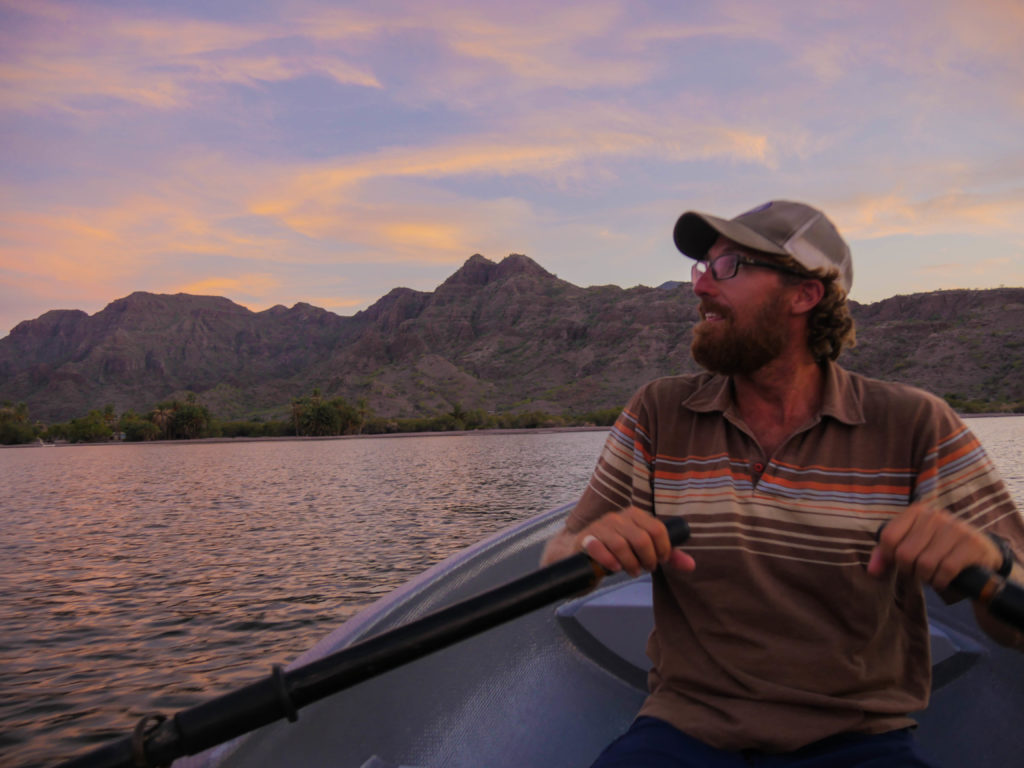
As the panga approaches, it slows down, and we now realize that it was intentionally aimed for us. The driver pulls alongside, as smooth and deliberate as a skier sliding the exact perfect distance on a groomed slope. I yell to him, joking, that WE need a motor.
“Well, we will give you a lift!” he says, smiling. Both Josh and I grab onto the fiberglass rail of his boat, and he gently picks up speed and aims for our sailboat.
The panga holds three demure women, and one little girl who can’t stop smiling and chattering to us. I ask them if they know the organization Niparajá, a Baja non-profit foundation deeply embedded in and committed to these coastal communities in the southern Sea of Cortez. It’s hard to hear anyone over the motor, but one of the women says she works for Niparajá. The driver adds that they were in town visiting his sister.
“We heard about you,” the driver says. I look up at him, confused.
“How?” I ask.
“From Pablo,” he says with a sly grin, as if I should have known. It takes me a moment to put it together: Pablo was the fishermen on the hill with whom we chatted on Isla Pardito—and who came down to the beach there and admired our dinghy.
In this moment, being shuttled out to our boat by a fisherman, I understand how connected these supposedly ‘isolated’ communities are. In less than a day, word traveled from a tiny island about two people rowing around in a dinghy who knew their friends at Niparajá. Pablo and this driver could have met out on the sea, but they were probably talking over the radio para pangas, the VHF radio, as we have heard all sorts of casual conversations on the airwaves. Or it may have just generally been chatted about on the radio, but either way, it felt good to know we were mentioned in a positive way in small-town conversation. It made me proud of our unusual dinghy—and grateful for the strong bonds Niparajá has created with the fishermen.
“It’s getting dark, do you want a light?” I ask as they drop us off at our boat.
“No, we’re just around the point,” he says, gesturing to the land that protects San Evaristo from the northern swell. We thank them, and without ever bumping his 26-foot boat into ours, he glides out into the night.
From San Evaristo, we sail along the mainland, which keeps us out of the path of luxury yachts and protects us from the nighttime westerly swell, since we are tucked into the land.
Nopolo
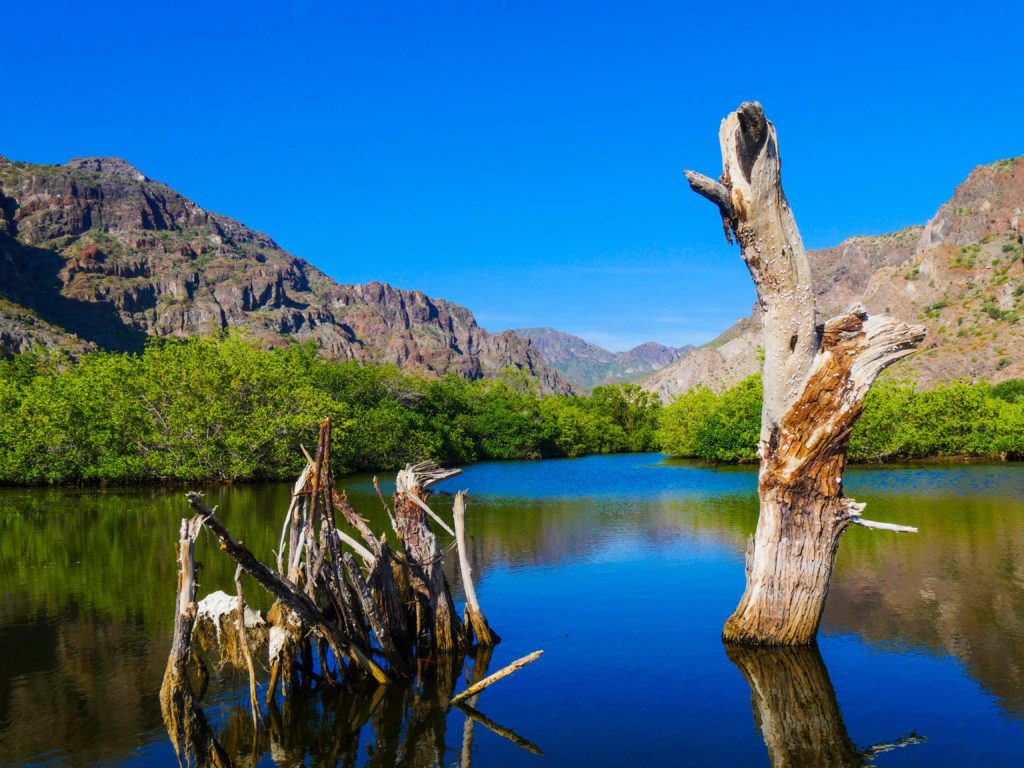
We stop in Nopolo, a fishing village at the mouth of a green canyon that rises steeply on both sides. No roads can access this rugged coast. This tiny village is composed only of fishers and their families, and we exchange giggles with two young girls playing in the water as we row ashore. There, we find a dilapidated, abandoned fish camp. Tucked into a cave, a wooden canoe slowly disintegrates next to the mangrove-filled canyon. The bells of burros tinkle on the steep hillsides.
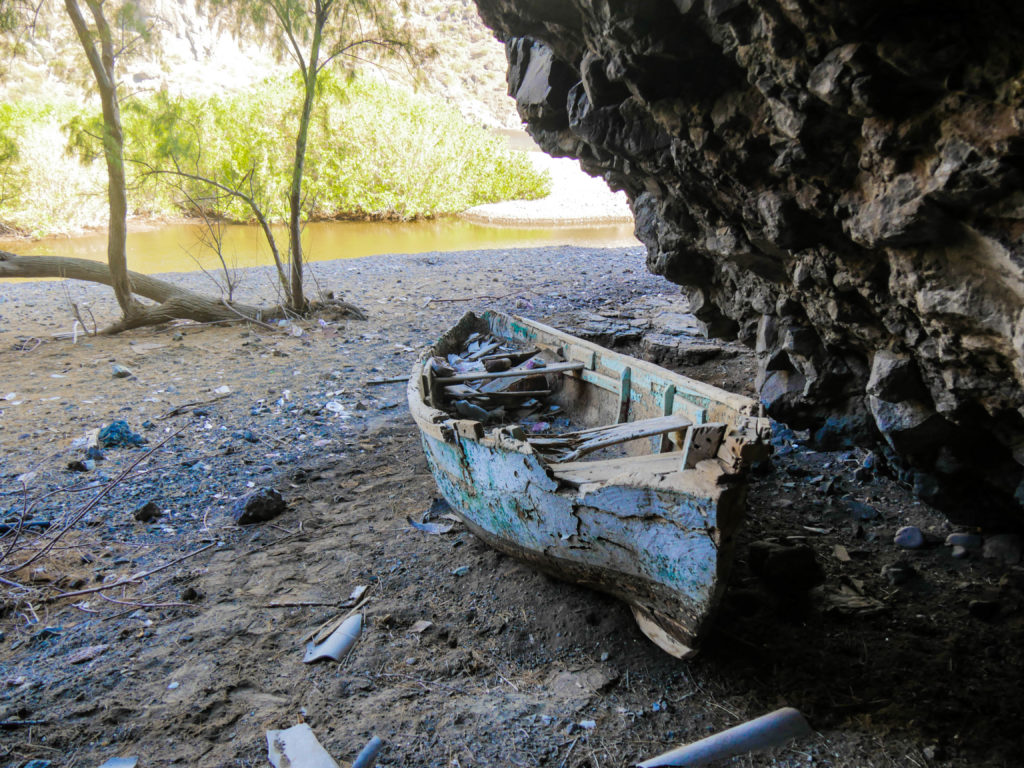
“Look, this was a sailing canoe,” Josh whispers, pointing to the hole in the boat for a mast. With the eye of a wooden boat builder, he points out the trunnels, the ‘tree nails’ that hold the boat together with wood, not metal. The boat has trash inside from people using the cave, but it doesn’t affect the dignity of this well-built wooden boat. Further down the wash, we find a gravesite, partially dug up and disturbed by flood waters that must rip down this canyon during a heavy rain. One gravestone is marked ‘Castillo León, 1849-1935.’ People have been fishing here for a long time.
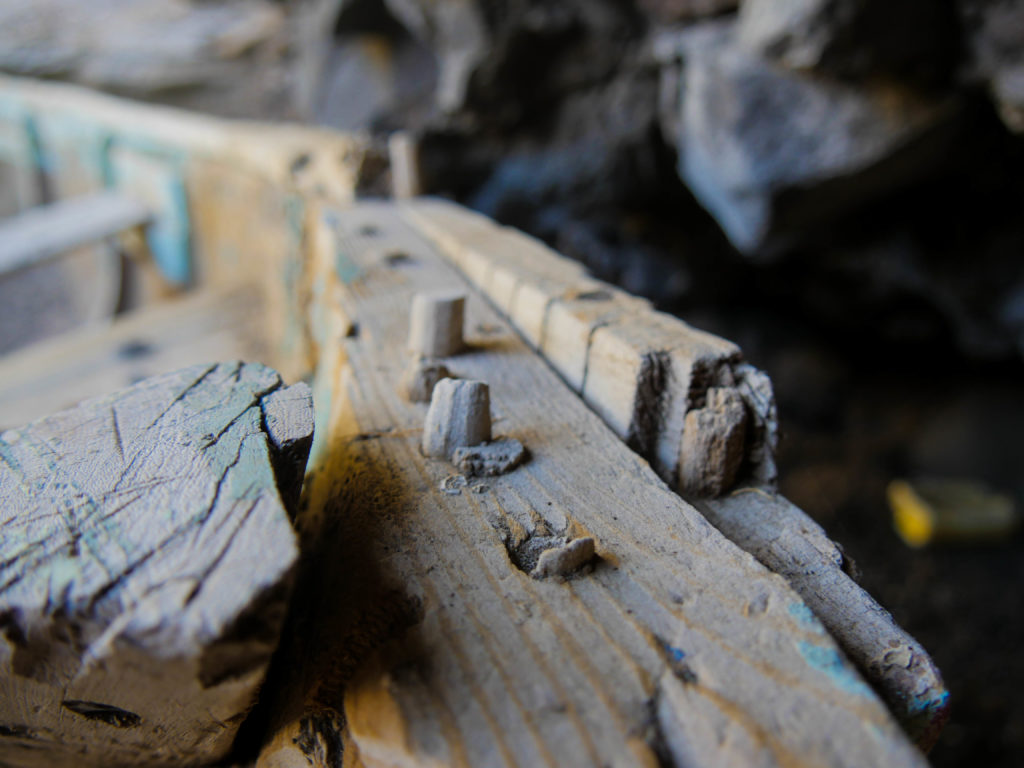
On the morning that we leave this lovely green canyon, we are joined by a pod of Pilot Whales, a relative of the Killer Whale. We motor with them on the glassy water for ten minutes until they turn and head south. It’s hard not to feel like our blue road has led us into a new world, one where the fears of modern life haven’t reached the animals or the people.
Agua Verde
A close friend described Agua Verde as her favorite place on the coast, and she infused it with a sense of magic and belonging for me. As we sail into the bay, dodging a hundred-plus foot pinnacle sticking out of the sea, we find the calmest water we have seen. We anchor on the north side of the large bay, next to a strip of white sand beach. After swimming to shore, we find an old man listening intently to the radio under the shade of his sand porch. He ignores us.
That evening, Josh calls me out to the cockpit. Someone is walking in the water, directly under the cliffs that line the cove. With the binoculars, I can see that it is the old man from the beach shack. He carries a bag of groceries over his shoulder, and uses his free hand to steady himself against the cliff walls. He walks a few steps, then leans over. My heart breaks. I jump in the dinghy and row over to him and offer him a ride. He declines, but not without a smile and a twinkle in his eye. Over the next few days, I start to chat with José. His young dog, Cascabel, starts accompanying us on our hikes up the hills. After a few days, I interview him about change under the patchy shade of his porch. His sits in a red metal rocking chair.
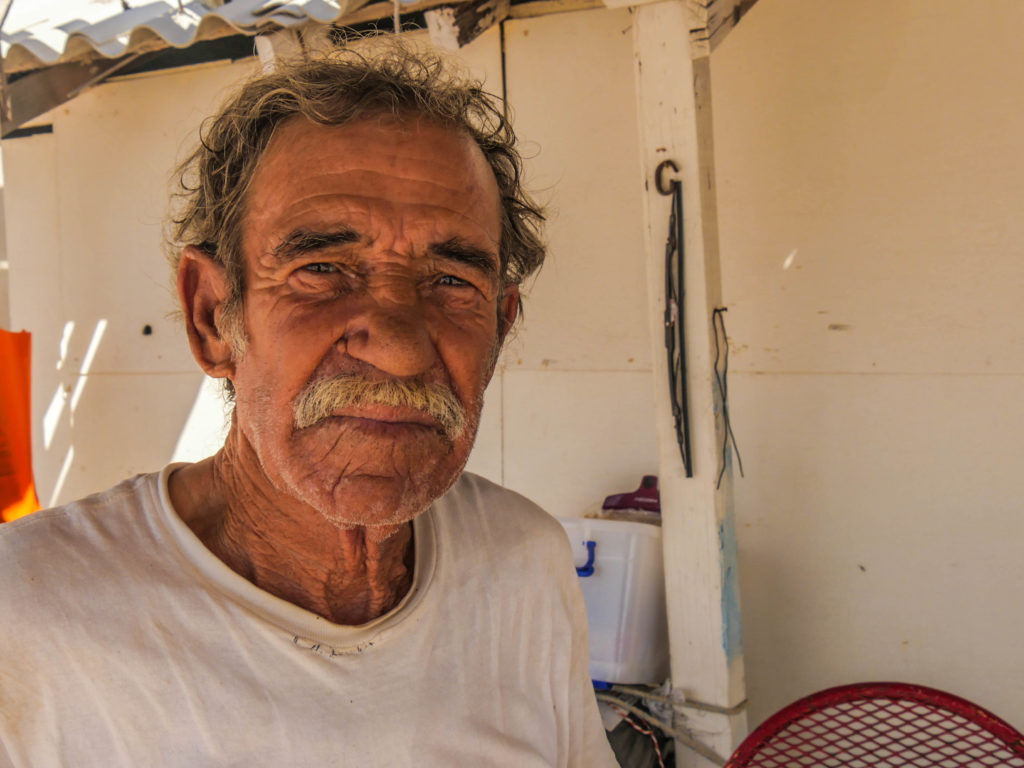
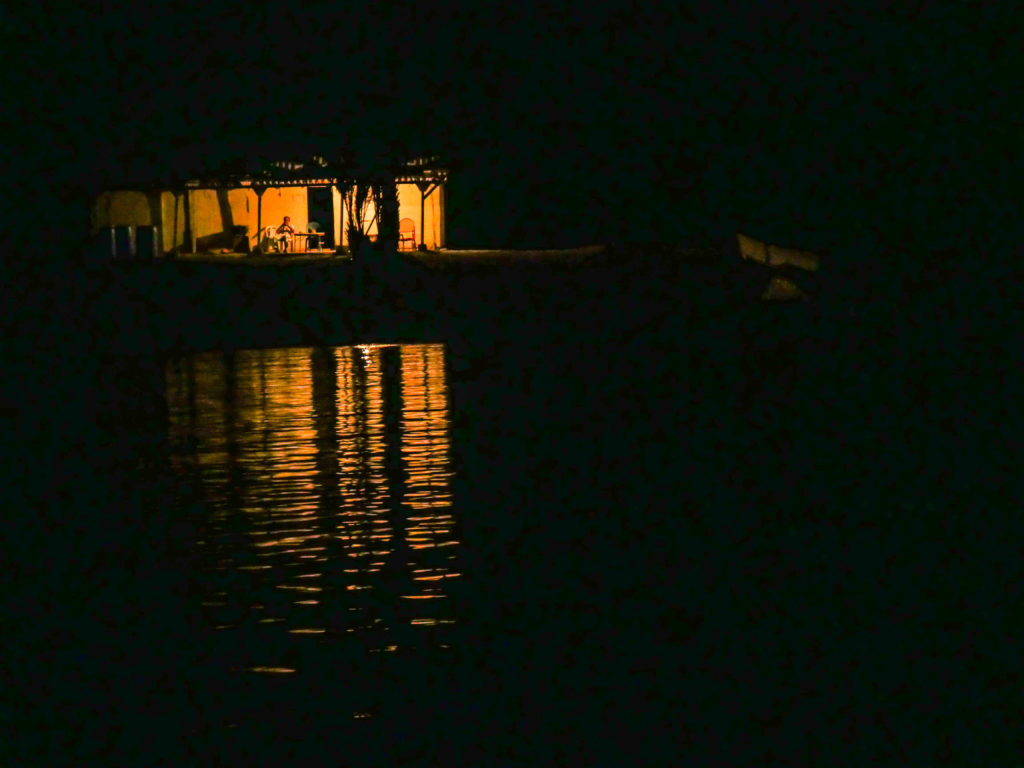
José is kind and thoughtful, though it soon becomes clear that his world has shrunk to the size of the little beach he calls his home. He came there almost 20 years ago, and despite not finding anyone with title to the land, or perhaps because of that, he built a little building, then moved to the only other structure on the sand, a previously abandoned shack. He likes the shack better because it doesn’t leak when it rains. The land is a little rise of sand flanked on the north and south by a beach, and steep hills on the east and west, leaving him about 10,000 square feet and six big acacia trees. When asking him about change, he couldn’t think much of change in the past, but knew that this year was hotter and drier—his little spot even more so than town, he claims. He worries about his trees.
His inability to remember might have also been because of some unknown head trauma he had as a child, it sounded like perhaps from a blow from an abusive father, which damaged his short-term memory. In his childhood, he was teased as soon as he went to school at age nine because he struggled to read and remember, so his mother pulled him out immediately. He never went back, and after leaving Jalisco 36 years ago he made his way first to the port of San Carlos, in Magdalena Bay, then to Mulegé, where he learned to fish. He sits up tall and proud when he says his profession: pescador.
At age 77, his legs really bother him, so he can’t fish anymore (it takes a lot of leg muscle to stand and pull a fish up from the ocean on a hand line.) There is no family around to care for him, and he seems to have sequestered himself in his sliver of paradise. However, he has visitors: individuals and families come every year, and they cook food to share with him and give him a little money. In his stories, he often says he worked “just to eat, I just need to eat.” So now, it’s like your occupation is tourism, I say, and he laughs and agrees. Subsistence tourism, I muse, from a ramshackle one-room cabin on a tiny beach in remote Baja.
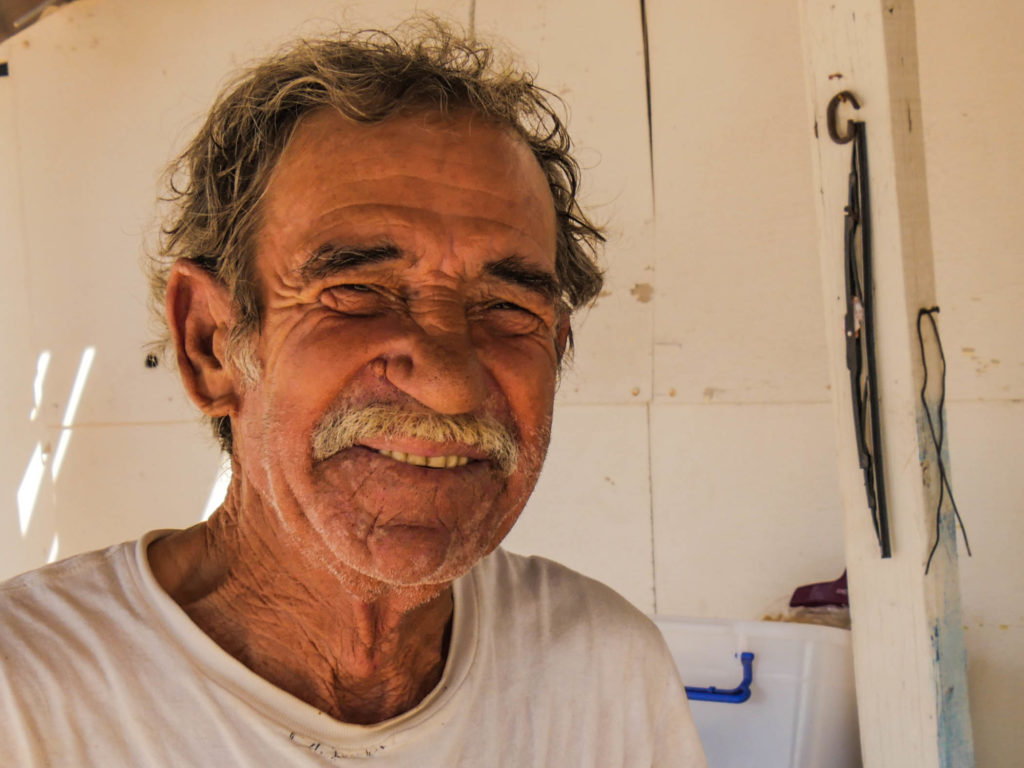
Josh and I leave him with homemade energy bars and coffee, and once we anchor in front of town, we are in for a treat: the people of Agua Verde. We land the dinghy on shore and stroll past happy pigs snorting in the mud on the beach. We make our way over to two men sitting on a boat trailer at the edge of the beach, awaiting the arrival of the evening fishers. Chayo and Vincente show off their English, and when I ask about a restaurant in town, they tell me that the owner of the store, Esperanza, would perhaps cook something for us. We walk a sandy two-track through the salt bush, past posturing turkeys and curious goats, through the maze of sand roads to find the store.
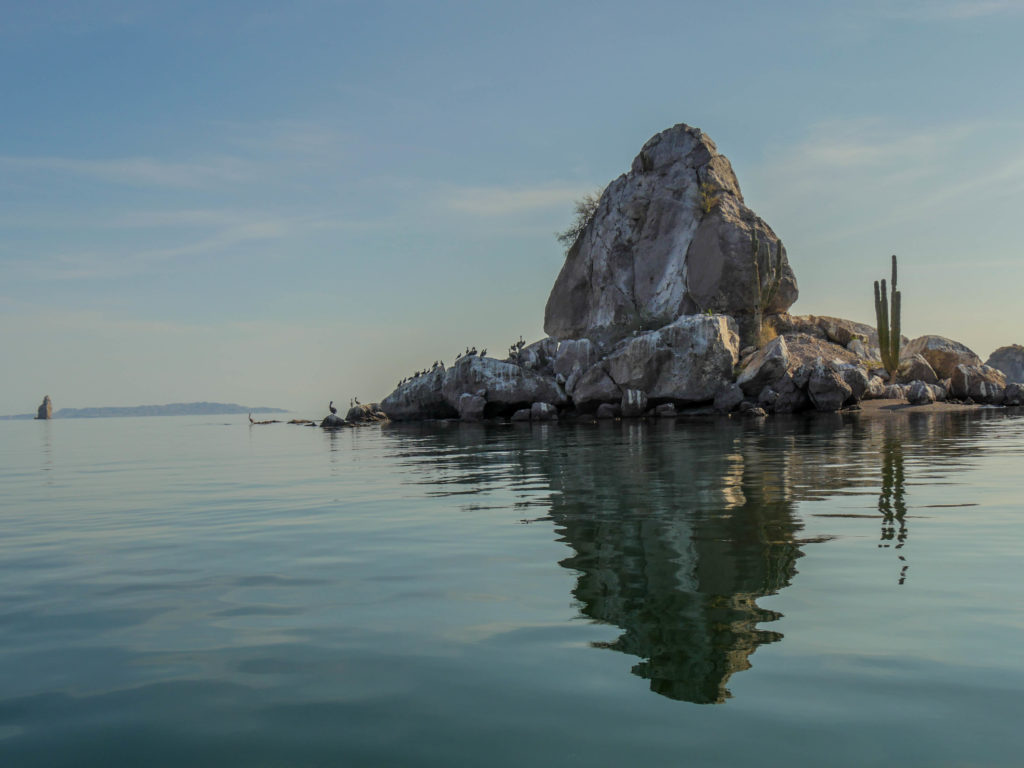
“I can make fish and rice,” Esperanza tells me, “just let me know when you can come back.” We returned at dusk for a meal on her front porch, just the two of us—and her whole family. The porch is a slab of concrete and a sparse wooden frame, but its presence and comfort come from the cheerful family. A fresh-caught jurel (yellowtail) watches us eat our fish and rice wrapped in fresh corn and flour tortillas, with a shredded carrot and cabbage salad, sour cream, and green salsa. A 15-watt bulb lights the porch; the women pull apart or twisted together two wires overhead to turn the light on and off. Jovial men stop by throughout our dinner; Don Panfilo pats Josh’s shoulder when he arrives on the porch to talk about the latest town news, and Esperanza’s husband, Miguel, sits down and jokes about free goods from Esperanza’s market. Esperanza and her two nieces smile, sweating gracefully in the still, hot air of the night. Esperanza fans herself by whirling a cloth horizontally in front of her chest (try it next time you have a dishcloth, it’s not as easy as it sounds without wrapping it immediately around your hand.) I perspire constantly in lightweight shorts and shirt, and they sit in tight jeans, never complaining about the heat.
I asked how many people live in town. Four hundred, they tell me—far more than I thought. They smile and say yes, they live up the arroyo. How many of those are fishermen? I ask.
“All of them!” they exclaim, laughing. I think of the wooden fishing boat. Miguel’s family has been here for at least four generations. It feels like a privilege to eat fresh fish in the company of this generous family. This is our first night here, and we get to share his front porch.
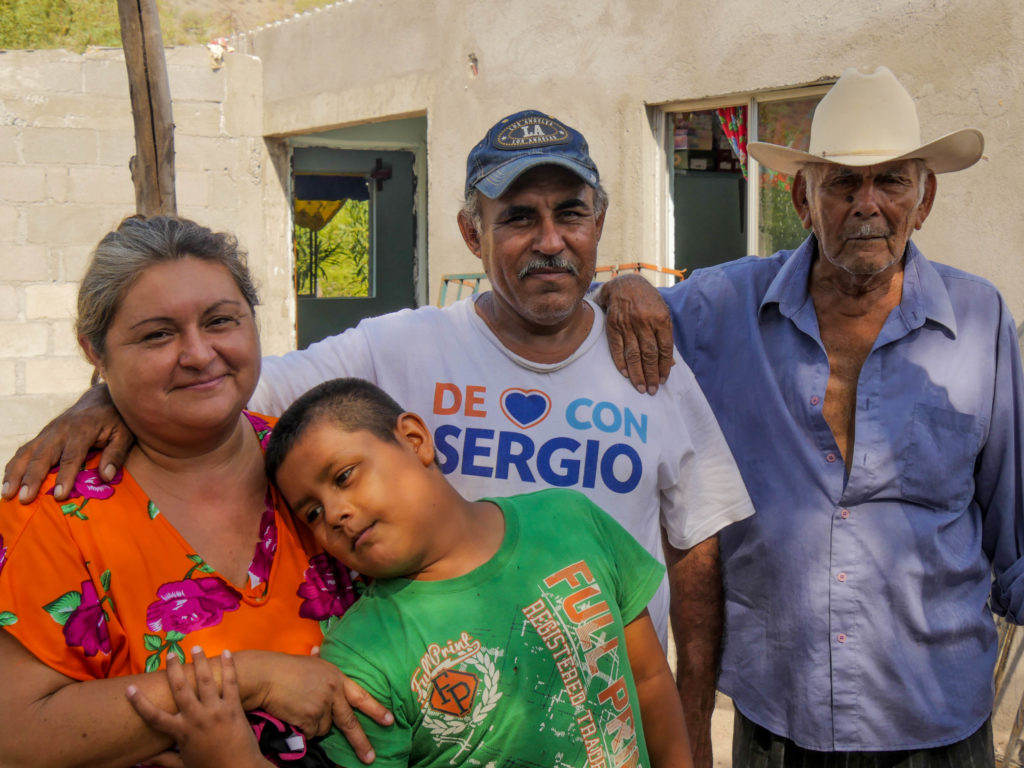
In the morning, the pangas roll out to the beach on simple trailers, towed by pickups, and groups of two and three men aboard speed out to sea. Do they not take a day off? Josh wonders aloud. Throughout the morning, we hear the roar of old Toyota Forerunners, followed by the gurgle and growl of the panga outboards. Kids screamed and giggled on the water, chasing each other around the boats and the parents.
Over the next evenings, we see the fishermen bringing in the catch of the day. They lift coolers heavy with ice and fish from the pangas and stagger over to the waiting truck by fishermen in white rubber boots. They toss fish through the air into the truck that brings ice in the morning, then returns for their fish in the evening. The fish are large enough to see mid-flight from our boat a couple of football field lengths away. Tough work with long hours.
Fishing here is not just a way to earn a living, but a way of life for entire families and this whole town. Men, women, and children all take to the shore. The coming and going from the water’s edge is like community worship at the church of the sea, twice a day.
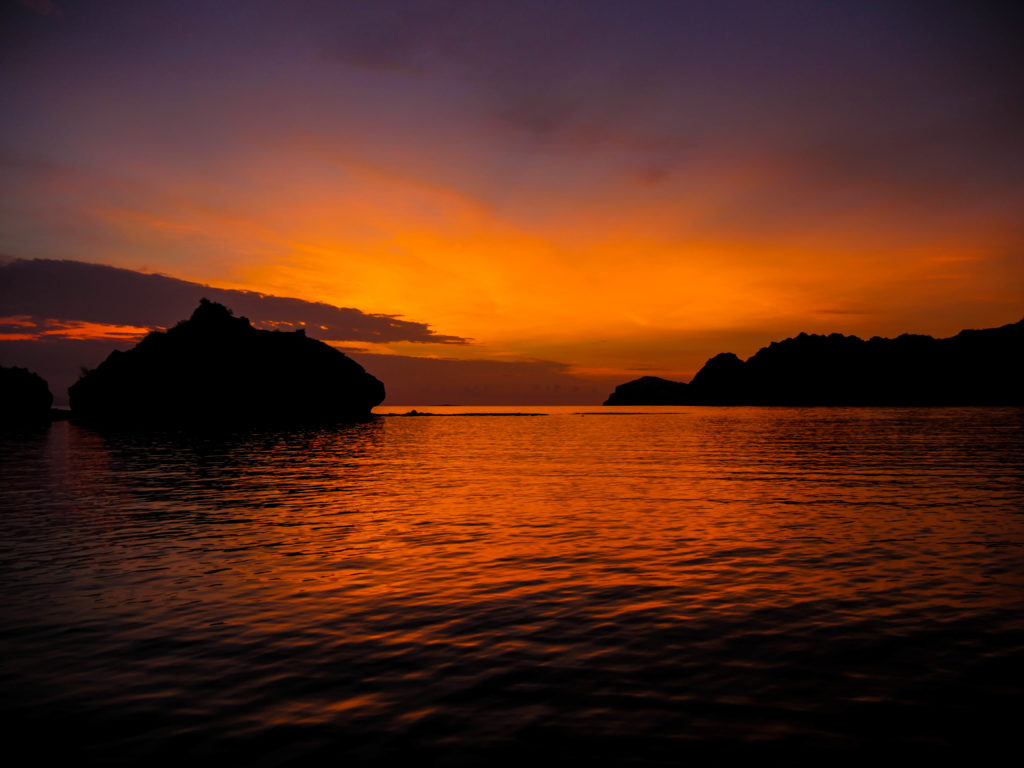
Is life really easier with more? The people of Agua Verde live in houses with no windows, no fans, and no pavement. Their lives are open to the weather. Esperanza doesn’t even have a light switch—but she and her nieces are so nimble with the wires that I didn’t notice their deft “switch” until Josh pointed it out. When I ask people why they stay here, they often us the word ‘tranquilo.’ People love the peacefulness here.
Agua Verde’s people, and those in Nopolo, San Evaristo, and Pardito, live at the edge of the sea, but also at the edge of society. They are separate from the sprawling and growing megacities. The fish dwindle, but the day-to-day life is simple, joyous, and deeply rooted here, in both the coastal land and the sea. As strangers, we showed up and everyone smiled at us without irony or contempt. They directed us toward home-cooked food, and once there the most honored and respected elders patted us on the shoulder like we belong.
We stay in Agua Verde for days. I interview people about climate change, and I learned that what people there think will change most in the coming years is tourism. For now, the road to the town is dirt and brings no electricity, but they know this will change soon. People bring this up with a sense of dread, but when I ask about it, they say that tourism will bring more work for the young people in town, and “that’s good, right?” People speak often about Niparajá, especially the courses that they offer that help them. They tell me that there are three fishing cooperatives, but I also learn that there are two cooperatives for the women as well, which surprises me. They seem ambivalent about ‘progress,’ resigned to the plans of faceless development.
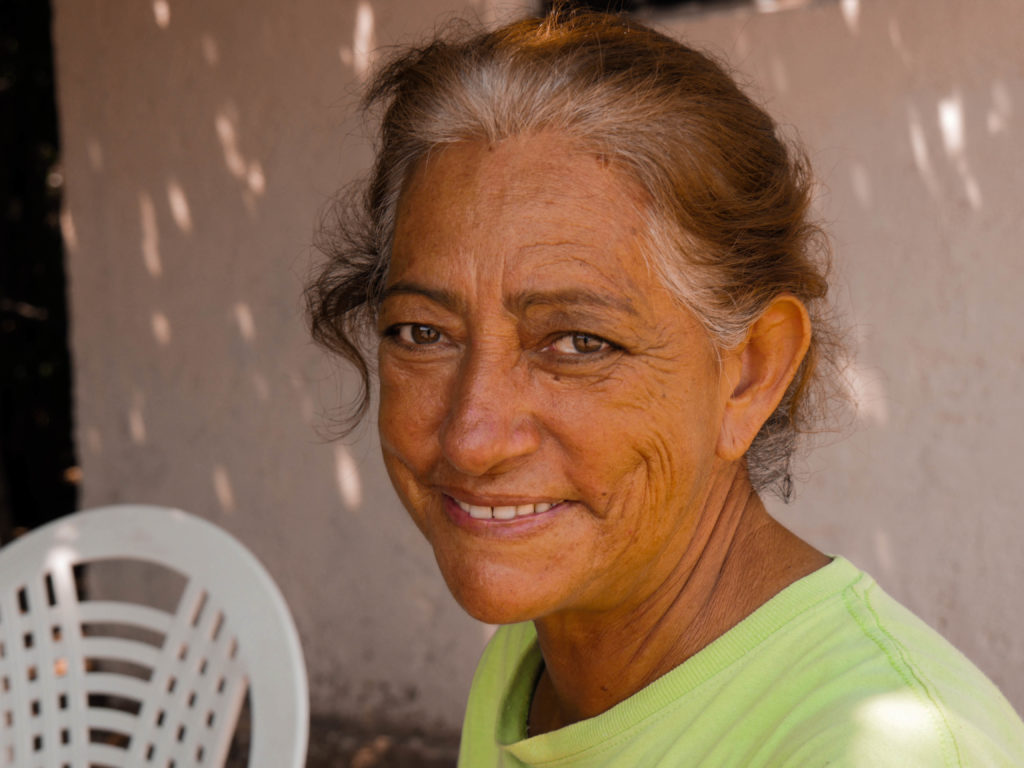
The women I interview are thoughtful, and their answers to my questions hint to me that they know that things are changing—not everyone can be a fisherman anymore. “Thank God for the school,” Esperanza says. Starting this year, the town’s school goes up to high school level, whereas most of the adults in town were only able to complete primary school education. Esperanza knows that education is the key for the local kids to find work in a changing world. The town knows it is vulnerable when all the income comes from only one source. More so than the rising sea, the singular source of income—based on exploited and declining fish populations—threatens this way of life.
The next day, we depart for Puerto Escondido, and aside from dodging dangerous reefs, we arrive without incident. This is a popular port for cruisers, but it’s conspicuously vacant. There is no town here, except for a development created by a branch of Mexico’s Secretary of Tourism, FONATUR, complete with clean bathrooms and over a hundred moorings for boats. We sleep well for the first time in three weeks in the calm waters of the natural lagoon. At night, bioluminescence twinkles in the water around the boat, and fish leave bright, comet-like trails under the hull.
There are very few sailboats on the moorings (which are floating balls anchored to the bottom, for use instead of an anchor,) and we are surprised to find that we are the only sailboat underway along this stretch of coast. When I ask the FONATUR administrator if there are fewer boats this year, she tells me yes, far fewer. However, the dry storage, where boats are hauled out of the water, is full. She guesses that Hurricane Odile scared many sailors last September. In Puerto Escondido, boats washed ashore and became tangled as moorings unexpectedly dragged in the harbor. This powerful storm continues to impact tourism a year later.
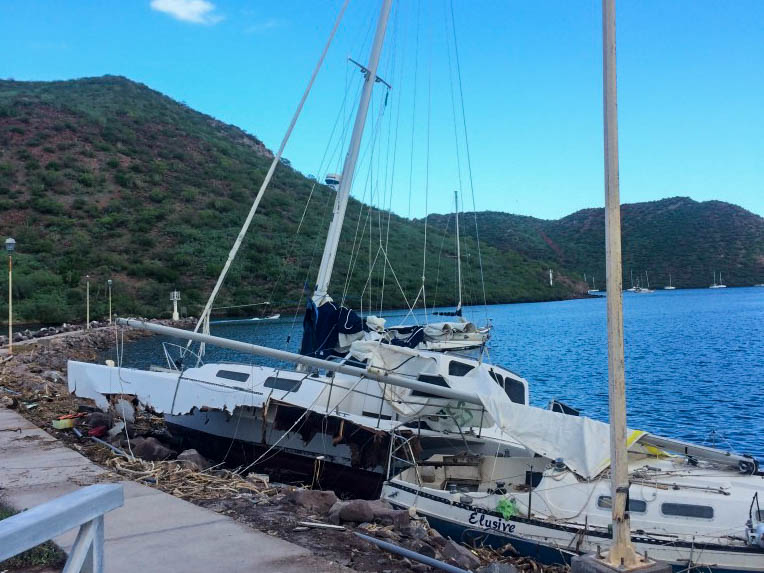
* * * * *
The afternoon we leave Agua Verde, a beat-up green kayak with two kids shows up at our boat. Soon, four more kids appear at our swim ladder at the back of the boat. They snorkeled from shore while diving for almejas chocolatas, chocolate clams. Now we have a cockpit full of shivering, dripping boys. I throw them towels and give them glasses of fresh water. They peer into the cabin, so I offer to give them a tour, and they bashfully accept. One notices the stuffed animal in the v-berth, an octopus. They all notice the photo above the chart table of my dog who passed away last year, Keogh. He’s so handsome, they say in awe, lingering on the photo. They are the first people to notice it.
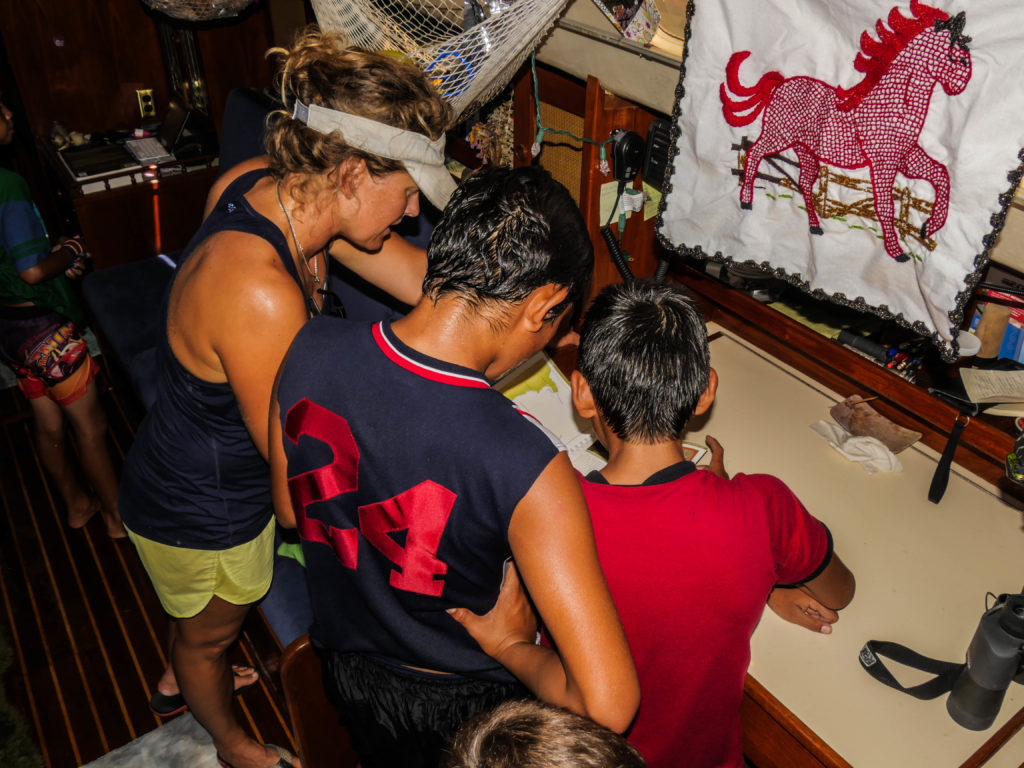
Soon, the kids are relaxed with us and turn the boat into a waterpark. They jump from the rails and the lifelines, showing off their splashes and chortling with the uncontrollable laughter of kids as they run up the swim ladder and fall into the water again.
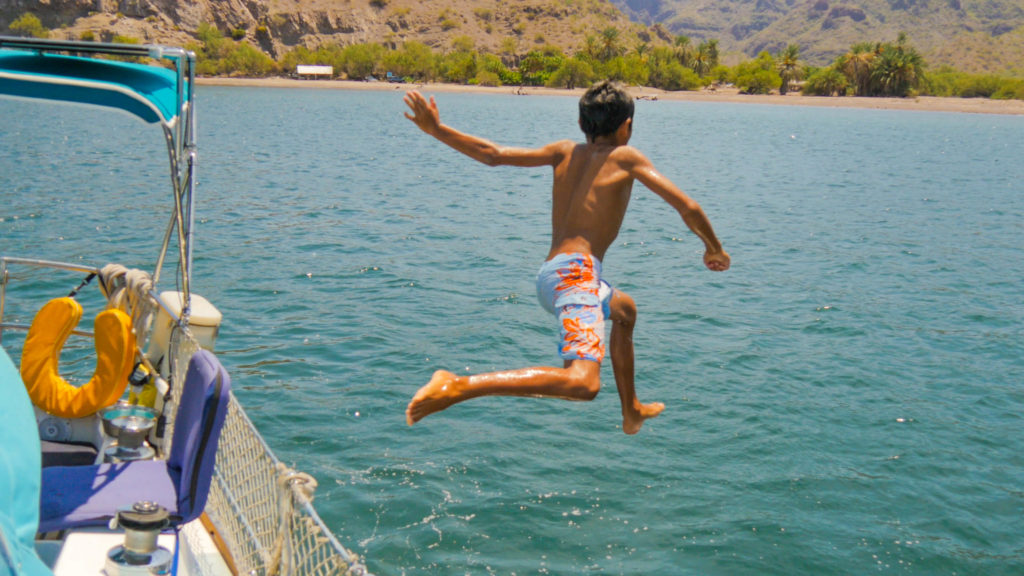
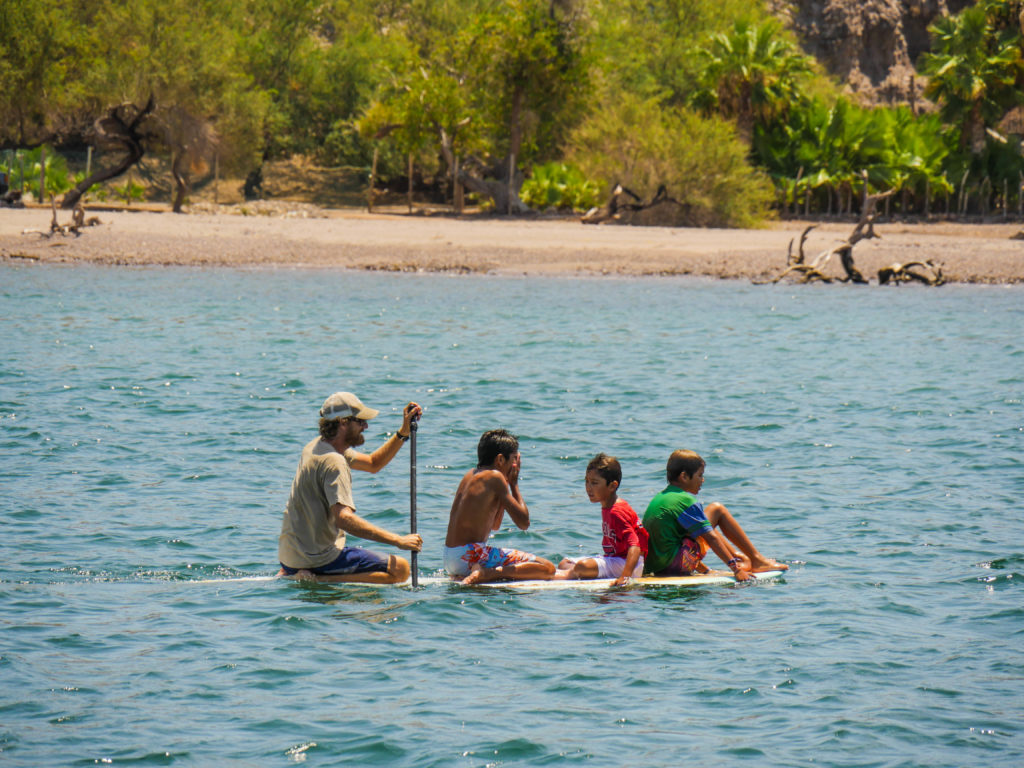
I ask them all if their fathers are fishermen, and they all reply yes.
“Do you want to be a fisherman when you grow up?” I ask.
“No,” they reply.
“Well, what do you want to be then?” I ask.
With water dripping from their clothes, each one of them replies the same:
“I want to be a marine biologist.”
